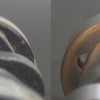probably due to being a novice, I found this article to be very helpful...thanks, stephen
http://www.tandlengines.com/tappet_vs_roller.html
Camshaft Tech: Flat Tappet vs. Roller
Upgrading to a roller camshaft; is it cost efficient?
Pictures and text by Eric LaBore
Camshafts have always been and continue to be the basis of argument among many engine builders and car enthusiasts alike. How much lift, the right duration, lobe centerlines and separation angles, there are so many aspects and conditions to consider. It requires many years of research, experience and an in depth understanding of the internal combustion engine to become an expert in choosing the best possible design. However, one thing that is widely agreed upon; for the best performance and reliability, a roller camshaft is the way to go.
There are two basic categories among camshafts; flat tappet and roller. Flat tappet cams are the ones most people are familiar with. Most of your V-8 engines in the muscle car era came standard with a flat tappet cam. The tappet, more commonly referred to as the lifter, is, for the most part, flat on the bottom. Oil film is the only thing between the lifter and camshaft lobe preventing them from welding each other together. Eventually, the cam lobes would wear down to a circular shape rather than the teardrop shape they started as. This, in turn, would not open the valves far enough to completely fill the cylinders with a fresh charge of air and fuel or allow the used charge to fully exit through the exhaust. A major loss in power and efficiency was the result. Fortunately, the roller cam almost completely eliminates this wear factor. Roller camshaft lifters are equipped with an actual roller that rides on the cam lobe. (Figure 1) This obviously results in a much longer lobe life due to the reduced friction.
In addition to the reliability factor, roller cams also have a great performance advantage over the flat tappet. The faster you can get the intake valve to maximum lift, the longer it can stay there before the piston comes rushing back up the cylinder to compress the air fuel mixture. If the goal is to load the cylinder with as much air and fuel as possible, the longer you are at maximum lift the better. Flat tappets require a smoother transition from the base circle of the cam to max lift, leaving less time for the lifter to dwell there. Roller lifters, on the other hand, can survive a much more abrupt transition resulting in extra time at max lift. If you compare a roller cam lobe to a flat tappet lobe, you can see the roller cam has a larger radius at its peak, holding the lifter at max lift for a longer duration. (Figure 2)
With all that said, I think you would agree that a roller cam is the better choice from a reliability and performance standpoint. Now let’s look at some of the things required with the use of a roller cam.
To keep lifters on a flat tappet cam wearing evenly, they are designed to rotate in the lifter bore with each revolution of the cam lobe. Not only is this not required on a roller lifter, it is definitely not desirable since rollers only work in one direction. There are two ways to eliminate the rotation of a roller lifter in its bore. On newer blocks that came standard with a roller cam, the top of the lifter bores are machined flat. The upper body of the lifters used with this type of block is also machined flat on two sides. This allows for the use of a special retainer, often referred to as a dog bone, which prevents lifter rotation. (Figure 3) If an older version block or a solid roller cam (often used in higher RPM and racing applications) is being used, tie bar lifters are required. In this design, the intake and exhaust lifters are connected by a flat bar preventing any rotation. (Figure 4)
To prevent cam walk, flat tappet cam lobes are slightly tapered, keeping the camshaft centered under the lifter bores. Since rollers must have a flat surface to roll on, roller cams require another way to keep the cam centered. Some blocks accept a retainer plate that bolts to the block behind the cam gear. Only a roller cam that is machined to accept this retainer can be used. (Figure 5) If the block or camshaft does not accept this retainer, a thrust button must be used. Thrust buttons fit between the front of the camshaft and the timing cover, preventing the cam from walking forward. (Figure 6) Rearward movement, in all cases, is controlled by the cam gear.
One last thing must be upgraded with the use of a roller cam. Since the opening and closing ramps of the cam lobes are usually more aggressive, a higher rate valve spring must be used. If not, the lifter could actually lose contact with the cam lobe at high RPM. The stronger spring will also prevent the valve from bouncing off its seat when it is slammed shut.
Original Post


